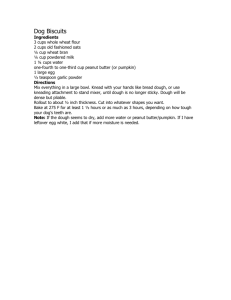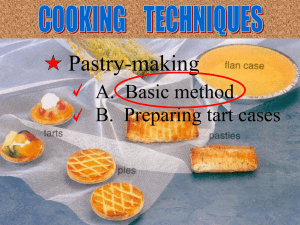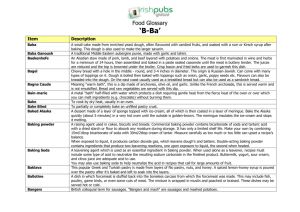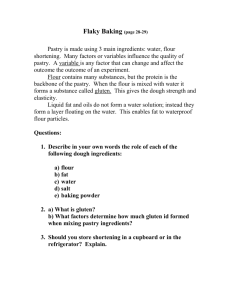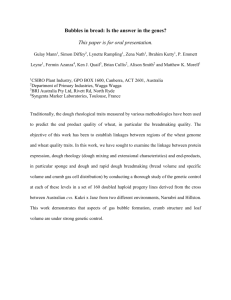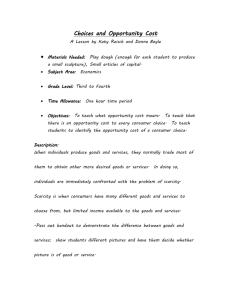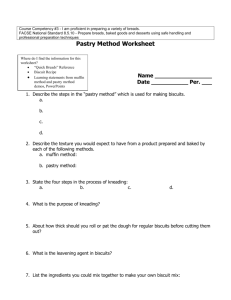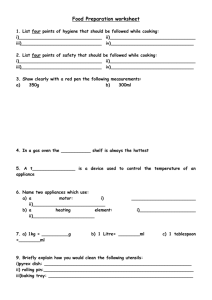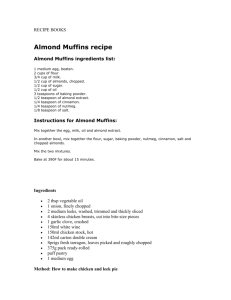Pastries Meringues
advertisement
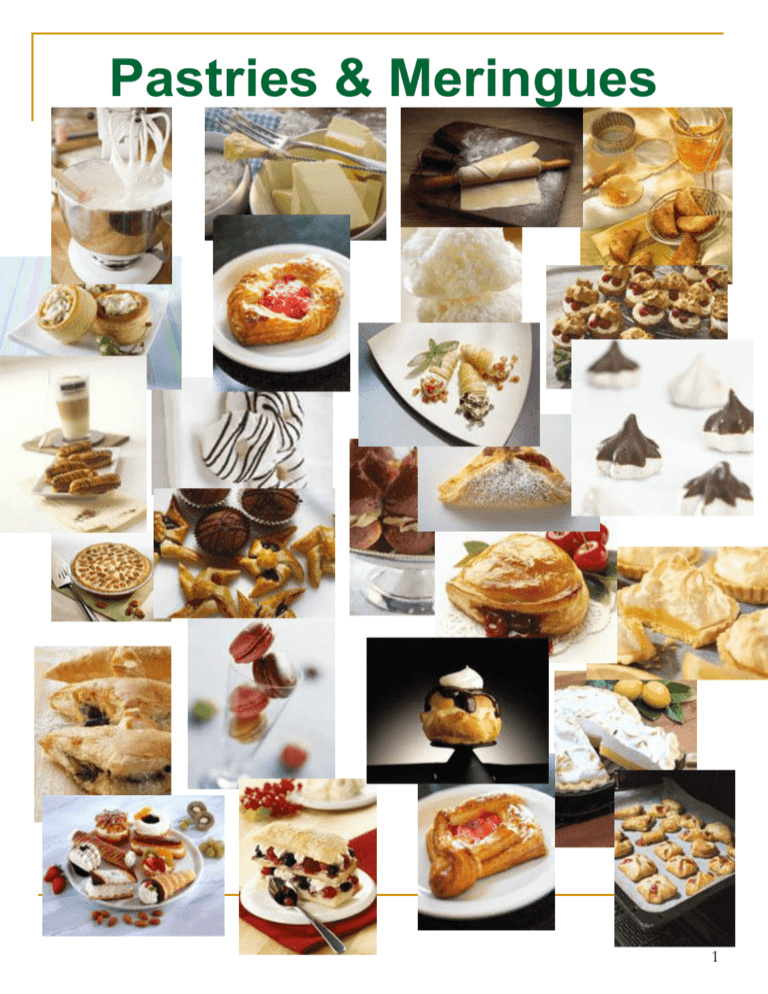
Pastries & Meringues 1 Contents Pastries & Meringues --------------------------------------------------------- 1 Contents --------------------------------------------------------------------------- 2 Pastries & Meringues ---------------------------------------------------------- 3 Pastries ---------------------------------------------------------------------------- 4 Puff pastry ------------------------------------------------------------------------- 5 Rolling-in procedure for puff pastry ----------------------------------------- 6 Blitz Puff Pastry ------------------------------------------------------------------ 7 Blitz Puff Pastry Recipe -------------------------------------------------------- 8 Makeup of pinwheels ----------------------------------------------------------- 9 Patty shells ------------------------------------------------------------------------ 10 Cream horns ---------------------------------------------------------------------- 11 Making Napoleons -------------------------------------------------------------- 12 Éclair Paste ----------------------------------------------------------------------- 13 Making Eclairs ------------------------------------------------------------------- 14 Meringues --------------------------------------------------------------------------15 Common meringue, Swiss meringue and Italian meringue ---------- 16 Japonaise meringues ---------------------------------------------------------- 17 Review & Questions -------------------------------------------------------------18 Blitz puff pastry Napoleon Eclair paste Pate a choux Profiteroles Soft meringue Hard meringue Common meringue Swiss meringue Italian meringue Meringue glacee Baked Alaska 2 Pastries & Meringues In this chapter you will study the preparation of puff pastry, éclair paste, meringues. In addition to pie dough, two other pastries also have great importance in bakeshops and kitchens: puff pastry, used for such products as napoleons and turnovers, and éclair or choux paste, used for éclairs and cream puffs. In addition, both these products are used in the hot food kitchen and the pantry, in the preparation of a number of hors d'oeuvres, entrees, and side dishes. Meringues dessert is also covered in this section. Meringues are not only important as pie toppings, but they can also be formed, baked until crisp, and then used in many of the same ways as pastry shells for desserts. 3 Pastries Puff Pastry Puff pastry is one of the most remarkable products of the bakeshop. Although it includes no added leavening agent, it can rise to eight times its original thickness when baked. Puff pastry is a rolled-in dough, like Danish and croissant dough. This means that it is made up of many layers of fat sandwiched in between layers of dough. Unlike Danish dough, however, puff pastry contains no yeast. Steam, created when the moisture in the dough layers is heated, is responsible for the spectacular rising power of puff pastry. Puff pastry or puff dough is one of the most difficult of all bakery products to prepare. Because it consists of over 1,000 layers, many more than in Danish dough, the rolling-in procedure requires a great deal of time and care. Like so many other products, there are nearly as many versions of puff pastry as there are bakers. Both formulas and rolling-in techniques vary. The formula provided here contains no eggs, for example, although some bakers add them. The folding-in technique used here differs somewhat from that used by European pastry chefs, although it is widely used by American bakers. Butter is the preferred fat for rolling in, because of its flavor and melt-in-the-mouth quality. Special puff pastry shortening is also available. This shortening is much easier to work with than butter because it is not as hard when refrigerated and it doesn't soften and melt as easily as butter at warm temperatures. It is also less expensive than butter. However, puff pastry shortening can be unpleasant to eat because it tends to congeal and coat the inside of the mouth. Skill at producing puff pastry requires careful attention to your instructor and diligent practice. Take special note of any alternative methods your instructor may present. Puff Pastry Ingredients: Amount Unit Baker's % Ingredients Preparation 0.8 kg 87.5 Bread flour see note 240 g 25 Cake flour 120 g 12.5 Butter, soft 15 g 1.5 Salt 0.4 kg 56 Water, cold 0.9 kg 100 Butter Procedure: 1. Place the 1.5 lb (250 g/75%) flour and the softened butter in a mixing bowl. With a paddle attachment, mix at low speed until well blended. 2. Dissolve the salt in the cold water. 3. Add the salted water to the flour and mix at low speed until a soft dough is formed. Do not overmix. 4. Remove the dough from the mixer and let rest in the refrigerator for 20 minutes. 5. Cream the last quantities of butter and flour at low speed in the mixer until the mixture is about the same consistency as the dough, neither too hard nor too soft. 6. Roll the butter into the dough following the procedure shown in images. Give the dough 4 four-folds 5 three-folds. Notes: The purpose of the 4 oz (125 g) bread flour is to absorb some of the moisture of the butter. Omit if puff paste shortening is used instead of butter. 4 Puff pastry Figure 1.1 Rolling-in procedure for puff pastry. 1. Dust the bench lightly with flour. Roll out dough about 1-1 ½ cm thick into a rectangle about three times as long as it is wide. Make the corners as square as possible. 3. Fold the third without fat over the center third. 5. Turn dough 90 degree on bench, so that the length becomes the width. This step must be taken before each rolling out so that the gluten is stretched in all directions, not just lengthwise. Failure to do this will result in products that deform or shrink unevenly when they bake. 2. Spot the butter evenly over two-thirds of the length of the dough as shown, leaving a 2 ½ -cm margin at the edges. The butter should be about the same consistency as the dough. If it is too hard, it will puncture the dough and not spread evenly. If it is too soft, it will ooze out when rolled. 4. Fold the remaining third on top. All ends and corners should be folded evenly and squarely. This procedure, enclosing the butter in the dough, does not count as one of the folds. The folding procedure starts with the next step. 6. Roll dough out into a rectangle. Make sure the corners are square. Roll smoothly and evenly. Do not press down when rolling, or layers may stick together and the product will not rise properly. 8. Fold the dough in half like closing a book. You have now given the dough one 4-fold. Refrigerate the dough for 15 to 20 minutes to relax the gluten. Do not refrigerate it too long or the butter will become too hard. (If it does, let soften a few minutes at room temperature before proceeding.) Give the dough another three 4folds, as in steps/to h. After another rest, the dough is ready to be rolled out and made up into the desired products. (Alternative method: Instead of giving the dough four 4-folds, you may give it six 3-folds.) See Figure 25.2 for the 3-fold method. 5 Rolling-in procedure for puff pastry Figure 1.1 Rolling-in procedure for puff pastry. 1. 2. 3. 4. 5. 6. 7. 8. 9. 6 BLITZ PUFF PASTRY BLITZ PUFF PASTRY This product is much easier and quicker to make than classic puff dough. ("Blitz" is the German word for "lightning.") It does not rise nearly as high as true puff pastry, so it is not suitable for patty shells and other products where a high, light pastry is desirable. However, it bakes up very crisp and flaky and is perfectly suitable for napoleons and similar desserts that are layered with cream fillings. Blitz puff paste, as you will see, is actually a very flaky pie dough that is rolled and folded like regular puff dough. GENERAL GUIDELINES FOR MAKEUP OF PUFF DOUGH PRODUCTS 1. Dough should be cool and firm when it is rolled and cut. If it is too soft, layers may stick together at the cuts, preventing proper rising. 2. Cut with straight, firm, even cuts. 3. Avoid touching the cut edges with the fingers, or layers may stick together. 4. For the same reason, avoid letting egg wash run down the edges. 5.Rest made up products for 30 minutes in a cool place or in the refrigerator before baking. This relaxes the gluten and reduces shrinkage. 6. Trimmings may be pressed together, keeping the layers in the same direction. After being rolled out and given another 3-fold, they may be used again, although they will not rise as high. PROCEDURE FOR MAKING TURNOVERS (SEE FIGURE 2.1) 1. Roll out puff pastry dough 1/8 inch (3 mm) thick. 2. Cut into 4-inch (10-cm) squares. Wash the edges of each with water. 3. Portion desired filling into center of each square. 4. Fold diagonally and press edges together. 5. Puncture tops with a knife in two or three places to allow steam to escape. Rest 30 minutes. 6. Brush tops with egg wash, if desired, or brush with milk or water and sprinkle with sugar. 7. Bake at 400°F (200°C) until crisp and brown. 7 Blitz Puff Pastry Blitz Puff Pastry Ingredients: Amount Unit Baker's % Ingredient 400 gr 50 Bread flour 400 gr 50 Pastry flour 900 gr 108 Butter 15 g 1.5 Salt 400 ml 50 Water, cold Preparation slightly softened Procedure: 1. Sift the two flours together into a mixing bowl. 2. Cut the butter into the flour as for pie dough, but leave the fat in very large lumps, 1 in. (2.5 cm) across. 3. Dissolve the salt in the water. 4. Add the water to the flour-butter mixture. Mix until the water is absorbed. 5. Let the dough rest for 15 minutes. Refrigerate if the bakeshop is warm. 6. Dust the bench with flour and roll out the dough into a rectangle. Give the dough three 4-folds. Variations: Reduce the butter to 75% (1 lb 8 oz/750 g). Figure 2.1 Makeup of turnovers. 1. Cut the dough into 4-inch (10-cm) squares. Wash the edges with water and place filling in center of each square. 2. Fold over diagonally and press the edges together. Puncture two or three steam holes in top. 8 Makeup of pinwheels PROCEDURE FOR MAKING PINWHEELS (SEE FIGURE 1.3) 1. Roll out puff dough 1/8 inch (3 mm) thick. 2. Cut into 5-inch (12-cm) squares. 3. Wash centers with water. 4. Cut diagonally from the corners to about 1 inch (21/2 cm) from center. 5. Fold every other corner into the center and press in place. 6. Bake at 400°F (200°C). 7. Let cool. Spoon desired fruit filling into centers. Dust lightly with confectioners' sugar. (Pinwheels may also be filled before baking if the filling is thick and not likely to burn.) Figure 3.1 Makeup of pinwheels 1. Cut the dough into 5-inch (12-cm) squares. Wash centers with water. 3. Fold every other corner to center and press down. 2. Cut diagonally from corners to 1 inch (2 ½ cm) from center 4 .Fill center with fruit filling before or after baking. 9 Patty shells PROCEDURE FOR MAKING PATTY SHELLS (SEE FIGURE 4.1) Roll out puff dough 1/8 inch (3 mm) thick. Roll out a second piece of dough 1/4 inch (6 mm) thick. Cut out the same number of circles from each piece of dough with a round 3-inch (772-cm) cutter. With a 2-inch (5-cm) cutter, cut out the centers of the thick circles. Wash the thin circles with water or egg wash and place one of the rings on top of each. Wash the top carefully with egg wash (do not drip wash down the edges). Rest 30 minutes. Place a sheet of greased parchment over the tops of the shells to prevent their toppling over while baking. Bake at 400°F (200°C) until brown and crisp. Figure 4.1 Makeup of patty shells. 1. Roll out one sheet of puff dough 1/8 inch (3 mm) thick and another sheet 1/4 inch (6 mm) thick. Cut out an equal number of 3-inch (7 ½ -cm) circles from each. Cut out the centers of the thick circles with a 2-inch (5-cm) cutter. 2. Wash the thin circles with water or egg wash and place the thick circles on top. 10 Cream horns PROCEDURE FOR MAKING CREAM HORNS (SEE FIGURE 5.1) 1. Roll out puff dough into a sheet 1/8 inch (3 mm) thick and about 15 inches (38 cm) wide. 2. Cut out strips 11/4 inches (3 cm) wide by 15 inches (38 cm) long. 3. Wash the strips with water. 4. With the washed side out, roll the strips diagonally onto cream horn tubes, making a spiral. Overlap the edges by about 3/8 inch (1 cm). If you are using conical tubes, start at the small end. 5. Roll in granulated sugar and lay on baking sheets. The end of the dough strip should be on the bottom so that it will not pop up during baking. Rest 30 minutes. 6. Bake at 400°F (200°C) until brown and crisp. 7. Slip out tubes while still warm. 8. Just before service, fill the horns from both ends with whipped cream or pastry cream, using a pastry bag with a star tip. Dust with confectioners' sugar. Figure 5.1 Makeup of cream horns. 1. Roll out puff dough 1/8 inch (3 mm) thick, and cut into strips 1 ¼ inch (3 cm) wide and 15 inches (38 cm) long. Wash the strips with water, and press one end (washed side out) onto one end of cream horn tube as shown. 2. Roll up the dough strip in a spiral by turning the tube. Overlap the edges by about 3/8 inch (1 cm). Do not stretch the dough. 3. Roll up completely and press the end in place to seal. 11 Making Napoleons PROCEDURE FOR MAKING NAPOLEONS 1. Roll puff dough into a very thin sheet about the size of a sheet pan. Blitz puff paste or rerolled trimmings may be used. 2. Place on sheet pan and let rest 30 minutes. 3. Dock with a fork to prevent blistering. 4. Bake at 400°F (200°C) until brown and crisp. 5. Trim the edges of the pastry sheet and cut with a serrated knife into equal strips 4 inches (10 cm) wide. Set the best one aside for the top layer. (If one of the strips breaks, don't be upset. It can be used as the middle layer.) 6. Spread one rectangle with Vanilla Pastry Cream or with a mixture of pastry cream and whipped cream. 7. Top with second sheet of pastry. 8. Spread with another layer of pastry cream. 9. Place third pastry rectangle on top, flattest side up. 10. Ice top with fondant 11. To decorate, pipe four strips of chocolate fondant lengthwise on the white fondant. Draw a spatula or the back of a knife across the top in opposite directions, 1. inch (2 ½ cm) apart, as shown in Figure 29.6. 12. Cut into strips 2 inches (5 cm) wide Figure 6.1 Decorating napoleons. 1. Spread the top of the assembled napoleon with white fondant. With a paper cone, pipe on four strips of chocolate fondant. 3. Draw the spatula in the opposite direction in the center of these 2-inch (5-cm) intervals as shown. 2. Draw a spatula or the back of a knife across the icing at 2-inch (5-cm) intervals. 4. Cut the napoleon into strips 2 inches (5 cm) wide. 12 Éclair Paste Éclair Paste Éclairs and cream puffs are made from a dough called éclair paste or choux paste. The French name pate a choux (pot a shoo) means "cabbage paste," referring to the fact that cream puffs look like little cabbages. Unlike puff pastry, éclair paste is extremely easy to make. The dough itself can be prepared in just a few minutes. This is fortunate, because for best baking results the dough should not be prepared ahead of time. In principle, éclair paste is similar to popover batter, even though one is a thick dough and the other a thin batter. Both products are leavened by steam, which expands the product rapidly and forms large holes in the center of the item. The heat of the oven then coagulates the gluten and egg proteins to set the structure and make a firm product. A strong flour is necessary for sufficient structure. Éclair paste must be firm enough to hold its shape when piped from a pastry bag. Occasionally you may find a formula that produces too slack a dough. Correct such a formula by reducing the water or milk slightly. Proper baking temperatures are important. Start at a high temperature (425°F to 475°F/215°C to 245°C) for the first 10 minutes to develop steam. Then reduce the heat to 375°F to 425°F (190°C to 215°C) to finish baking and set the structure. The products must be firm and dry before being removed from the oven. If they are removed too soon or cooled too quickly, they may collapse. Some bakers like to leave them in a turned off oven with the door ajar. However, if the oven must be heated again for other products, this may not be the best idea, especially in these times of high energy costs. It may be better to bake the products thoroughly, remove them carefully from the oven, and let them cool slowly in a warm place. Éclair Paste Ingredients: Amount Unit Ingredient 500 gr Water or milk or half water and half milk 250 gr Butter or regular shortening 5 gr Salt 375 gr Bread flour 625 gr Eggs Preparation Procedure: 1. Drain the apples and save the juice. 2. Add enough water to the juice to measure 650 ml. 3. Mix the cold water and starch 4. Bring the juice mixture to a boil. 5. Stir in the starch mixture and return to a boil. 6. Add the remaining ingredients (except the drained apples). Simmer until the sugar is dissolved. 7. Pour the syrup over the apples and mix gently. Cool completely. 8. Fill pie shells. Bake at 425°F (220°C) for about 30-40 minutes. 13 Making Eclairs PROCEDURE FOR MAKING ECLAIRS 1. Proceed as for cream puffs, except pipe the dough out into strips about ¾ inch (2 cm) wide and 3 to 4 inches (8 to 10 cm) long. Bake as for cream puffs. 2. Fill baked, cooled éclair shells with pastry cream. Two methods may be used: a. Make a small hole in one end of the shell and fill with a pastry bag or a doughnut filling pump. b. Cut a slice lengthwise from the top and fill with a pastry bag. 3. Dip the tops of the éclairs in chocolate fondant . 4. For service and holding, see cream puffs. Variation: Frozen Éclairs or Profiteroles 1. Fill éclairs or small cream puffs (profiteroles) with ice cream. Keep frozen until service. 2. At service time, top with chocolate syrup. PROCEDURE FOR MAKING CREAM PUFFS (Profiteroles) 1. Line sheet pans with silicone paper. 2. Fit a large pastry bag with a plain tube. Fill the bag with the choux paste. 3. Pipe out round mounds of dough about 1 ½ inches (4 cm) in diameter onto the lined baking sheets. Or, if preferred, dough may be dropped from a spoon. 4. Bake at 425°F (215°C) for 10 minutes. Lower heat to 375°F (190°C) until well browned and very crisp. 5. Remove from oven and cool slowly in a warm place. 6. When cool, cut a slice from the top of each puff. Fill with whipped cream, Vanilla Pastry Cream, or desired filling, using a pastry bag with a star tube. 7. Replace the tops and dust with confectioners' sugar. 8. Fill the puffs as close to service as possible. If cream-filled puffs must be held, keep refrigerated. 9. Unfilled and uncut puffs, if they are thoroughly dry, may be held in plastic bags in the refrigerator for a week. Recrisp in oven for a few minutes before use. 14 Meringues Meringues are beaten egg whites sweetened with sugar. Their most frequent use in this country is for pie toppings and cake icings (known as boiled icing). They are also used to give volume and lightness to butter-cream icings and to such preparations as dessert soufflés. Another excellent use for meringues is to bake them in a slow oven until crisp. In this form, they can be used in place of cake layers or pastry shells to make very light, elegant desserts. Chopped nuts may be folded into meringue before forming and baking, to make these desserts more flavorful. Basic rules for beating egg whites are discussed in Chapter 21, page 588. Please review this section before attempting to make any of the following preparations. We repeat one rule here because it is so important: Make sure that all equipment is free of any trace of fat or grease, and that the egg whites have no trace of yolk in them. Even a small trace of fat will prevent the whites from foaming properly. Soft meringues, those used for pie toppings, may be made with as little as 1 pound (450 gr)of sugar per pound (450 gr) of egg whites. Hard meringues, those which are baked until crisp, are made with up to twice as much sugar as egg whites. BASIC MERINGUES The stiffness to which meringues are beaten may vary, as long as they are not overbeaten until they are too stiff and dry. For most purposes, they are beaten until they form stiff or nearly stiff, moist peaks. 1. Common meringue is made from egg whites at room temperature, beaten with sugar. It is the easiest to make, and it is reasonably stable due to the high percentage of sugar. 2. Swiss meringue is made from egg whites and sugar that are warmed over a double boiler while beating. This warming gives the meringue better volume and stability. 3. Italian meringue is made by beating a hot sugar syrup into the egg whites. This meringue is the most stable of the three because the egg whites are actually cooked by the heat of the syrup. When flavored with vanilla, this meringue is also known as boiled icing. It is also used in meringue-type buttercream icings. Meringue Ingredients: Amount Unit Ingredient 400 gr Egg whites 800 gr Sugar Preparation Procedure: 1. With the whip attachment, beat the egg whites at high speed until they form soft peaks. 2. Gradually add the sugar with the machine running. 3. Continue to beat until the meringue forms stiff but moist peaks. Notes: For soft meringues to top pies, use the half the amount of sugar. 15 Common meringue, Swiss meringue and Italian meringue PROCEDURE FOR MAKING COMMON MERINGUE 1. With the whip attachment, beat the egg whites at high speed until they form soft peaks. 2. Gradually add the sugar with the machine running. 3. Continue to beat until the meringue forms stiff but moist peaks. PROCEDURE FOR MAKING SWISS MERINGUE 1. Place the egg whites and sugar in a stainless steel bowl or the top of a double boiler. Beat with a wire whip over hot water until the mixture is warm (about 120°F/50°C). 2. Transfer the mixture to the bowl of a mixing machine and whip at high speed until stiff peaks form. PROCEDURE FOR MAKING ITALIAN MERINGUE 1. Heat the sugar and water in a saucepan until the sugar dissolves and the mixture boils. Boil until a candy thermometer placed in the mixture registers 240°F (115°C). 2. While the syrup is cooking, beat the egg whites in a mixing machine until they form soft peaks. 3. With the machine running, very slowly beat in the hot syrup. 4. Continue beating until the meringue forms firm peaks. MERINGUE DESSERTS PROCEDURE FOR MAKING PIE TOPPING 1. Make Common Meringue or Swiss Meringue using equal parts sugar and egg whites. Beat until just stiff. 2. Spread a generous amount (2 to 3 cups/500 to 700 ml) of meringue on still warm pies. Mound it slightly and be sure to attach it to the edge of the crust all around. If this is not done, the meringue may slide around on the finished pie. Leave the meringue in ripples or peaks. 3. Bake at 400°F (200°C) until the surface is attractively browned. 4. Remove from oven and cool. 16 Japonaise meringues PROCEDURE FOR MAKING JAPONAISE MERINGUES These flavorful meringue layers are used like cake layers. They may be filled and iced with light buttercreams, chocolate mousse, whipped cream, or similar light icings and creams. 1. Prepare 1 recipe (1 lb or 500 g egg whites plus 2 lb or 1 kg sugar) Swiss Meringue. 2. Quickly but carefully, fold in 1 lb (500 g) finely chopped hazelnuts. 3. With a pastry bag or spatula, form circles of desired size, and about 1 ½ inch (1 ½ cm) thick, on parchment-lined sheet pans. 4. Bake as for meringue shells. PROCEDURE FOR MAKING BAKED MERINGUE SHELLS 1. Beat Common or Swiss Meringue until stiff. 2. Using a pastry bag or a spoon, form the meringue into small nest shapes on a parchment-lined baking sheet. 3. Bake at 200°F to 225°F (about 100°C) until crisp but not browned. This will take 1 to 3 hours. 4. Cool the shells and remove from the parchment. Be careful, because they may be very fragile. 5. Use in place of pastry shells for fruit tarts, fill with whipped cream and fresh strawberries or raspberries, or place a scoop of ice cream in shell and garnish with chocolate or raspberry sauce. Crisp meringues with ice cream make a dessert called meringue glacee. PROCEDURE FOR MAKING BAKED ALASKA 1. Pack softened ice cream into a dome-shaped mold of desired size. Freeze solid. 2. Prepare a layer of sponge cake the same size as the flat side of the mold and about 1/2 inch (11/2 cm) thick. 3. Unmold the frozen ice cream onto the cake layer, so that the cake forms a base for the ice cream. 4. With a spatula, cover the entire dessert with a thick layer of meringue. If desired, decorate with more meringue forced from a pastry bag. 5. Bake at 450°F (230°C) until meringue is golden brown. 6. Serve immediately. 17 Review & Questions Blitz puff pastry Napoleon Eclair paste Pate a choux Profiteroles Soft meringue Hard meringue Common meringue Swiss meringue Italian meringue Meringue glacee Baked Alaska 1. Why is it important to bake cream puffs and éclairs thoroughly and to cool them slowly? 2. Briefly describe the difference between common, Swiss, and Italian meringues. 18
